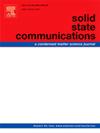非磁性元素共掺杂半导体氧化物的最新进展
IF 2.4
4区 物理与天体物理
Q3 PHYSICS, CONDENSED MATTER
引用次数: 0
摘要
光电子和自旋电子学领域的器件需要密切关注非磁性掺杂半导体氧化物材料这一新的子领域。由于光电子器件对各种行业的广泛应用和贡献,它们已经成为社会各个方面不可或缺的一部分。这些设备在许多领域都非常重要,包括医学成像、电子通信、数据传输和可再生能源等。另一方面,自旋电子器件依赖于电子学领域,它利用电子的自旋特性加上它们的基本电子电荷来进行数据记录和传输。研究在许多不同的方向上进行,其中之一是研究用于自旋电子应用的铁磁氧化物半导体,特别是那些具有高居里温度的半导体。在本文的范围内,概述了非磁性元件共掺杂半导体氧化物材料的发展。这些材料包括SnO2, TiO2和ZnO。对这些材料的实验结果进行了探讨,重点研究了它们的结构、光学、输运和磁性。本文章由计算机程序翻译,如有差异,请以英文原文为准。
Recent developments in non–magnetic elements co–doped semiconducting oxides
Devices in the fields of optoelectronics and spintronics need to pay close attention to a new subfield of non–magnetic doped semiconducting oxide materials. Due to the wide range of applications and contributions that optoelectronic devices have made to a variety of industries, they have become indispensable in different aspects of society. These devices are extremely important in a variety of fields, including medical imaging, electronic communications, data transport, and renewable energy, among others. On the other hand, spintronic devices, are dependent on the electronics field that utilizes the spin property of electrons plus their fundamental electronic charge for the purpose of data recording and transporting. Research has been going on in a number of different directions, one of which is the investigation of ferromagnetic oxide semiconductors for spintronic applications, particularly those with high Curie temperatures. Within the scope of this article, an overview is provided on the development of non–magnetic elements co–doped semiconducting oxide materials. These materials include here are SnO2, TiO2, and ZnO. The experimental findings from the ongoing study on these materials are explored, with an attention on investigating their structural, optical, transport, and magnetic properties.
求助全文
通过发布文献求助,成功后即可免费获取论文全文。
去求助
来源期刊

Solid State Communications
物理-物理:凝聚态物理
CiteScore
3.40
自引率
4.80%
发文量
287
审稿时长
51 days
期刊介绍:
Solid State Communications is an international medium for the publication of short communications and original research articles on significant developments in condensed matter science, giving scientists immediate access to important, recently completed work. The journal publishes original experimental and theoretical research on the physical and chemical properties of solids and other condensed systems and also on their preparation. The submission of manuscripts reporting research on the basic physics of materials science and devices, as well as of state-of-the-art microstructures and nanostructures, is encouraged.
A coherent quantitative treatment emphasizing new physics is expected rather than a simple accumulation of experimental data. Consistent with these aims, the short communications should be kept concise and short, usually not longer than six printed pages. The number of figures and tables should also be kept to a minimum. Solid State Communications now also welcomes original research articles without length restrictions.
The Fast-Track section of Solid State Communications is the venue for very rapid publication of short communications on significant developments in condensed matter science. The goal is to offer the broad condensed matter community quick and immediate access to publish recently completed papers in research areas that are rapidly evolving and in which there are developments with great potential impact.
 求助内容:
求助内容: 应助结果提醒方式:
应助结果提醒方式:


